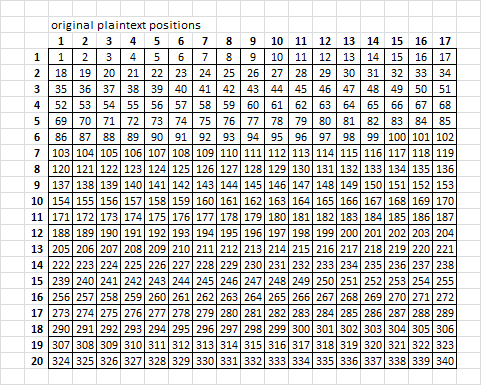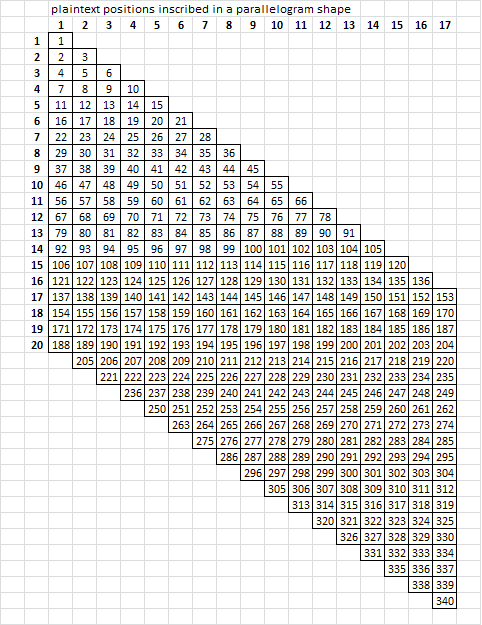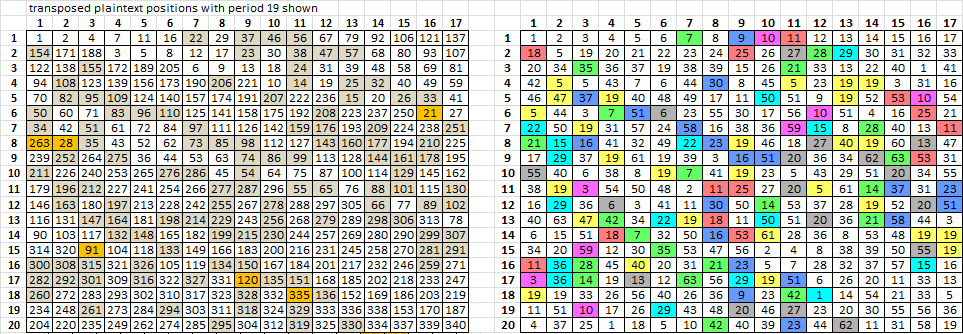"Polyliteral transposition. A variation may be made in the size of the unit transposed. One need not transpose single letters at a time. Pairs of letters, or groups of three, four or five letters may be employed in the same manner as that used in monoliteral or single letter transposition."
I forgot I had this until I read your post and went looking through my files. If you are interested in this line you might want to look at military cryptanalysis parts I, II, III and IV unclassfied by the NSA in 2005. It discusses a variety of techniques, including, uniliteral and monoliteral.
Soze
I just completed a test comparing the smokie27 and 340 ciphers.
17 by 20 row randomization average m_2s_cycles score / base score. (10000 samples)
Smokie27a: 1326 / 2029. (transposition cipher)
Smokie27b: 1409 / 2380.
Smokie27c: 1321 / 2204.
Smokie27d: 1456 / 2108.
340: 1576 / 2152.
The average for the 340 is 1576. It’s 120 points higher than the smokie27d.
"Polyliteral transposition. A variation may be made in the size of the unit transposed. One need not transpose single letters at a time. Pairs of letters, or groups of three, four or five letters may be employed in the same manner as that used in monoliteral or single letter transposition."
I forgot I had this until I read your post and went looking through my files. If you are interested in this line you might want to look at military cryptanalysis parts I, II, III and IV unclassfied by the NSA in 2005. It discusses a variety of techniques, including, uniliteral and monoliteral.
Soze
Thanks. Part IV covers transposition, and is very interesting.
EDIT: Part IV of Section VIII discusses combined substitution-transposition systems, and under 35f. explains that without a substitution key, a cryptanalyst must experiment with different transpositions. It says that the correct transposition scheme will disclose the repetitions in the plaintext.
My favorite part is under 35g.: "This, however, is admittedly a slow and difficult process even under the most favorable conditions; and if the rectangle is incompletely filled the process is very difficult. For in the latter case the lack of absolutely clear-cut knowledge as to the lengths of the columns, the juxtaposition of columnar material becomes replete with uncertainties and engenders feelings of confusion, hopelessness, and inadequacy in the mind of the cryptanalyst."
Jarlve, you should skim through Part IV. There are some interesting geometric shapes, similar to trapezoids, that could cause period 19 repeats.
I am working on a new transposition interpretation that is very, very interesting. And I am very excited. Will post soon.
EDIT: Looking at the transposition chapters in some books, I saw different geometric shapes besides just rectangles. I saw trapezoids, triangles, diamonds, and interesting hat shapes. So what about a parallelogram that starts as a 17 x 20 message, ends with a 17 x 20 message, and creates period 19 repeats?
Here is the plaintext tracing map for the original message. The numbers in the cells are not symbols, they are positions:
Here is the inscribed parallelogram:
And here is the transposed message, transcription top down left right. It creates a lot of contiguous symbol period 19 positions. I marked a diagonal row of them with blue boxes to show. The orange shaded cells are the ones where the symbol positions do not create period 19 either diagonally up or down:
Would the orange shaded positions cause misalignments during EDIT: rectangular un-transposition, or otherwise what effect would they have on a EDIT: rectangularly un-transposed message ( I haven’t gotten that far yet )?
edit: are you going to use the numbers 6,8,9,10,11?
Mr. Lowe, see above your post. ![]()
Here is the transposed tracing map side by side with the 340 period 19 repeats:
There are a few shaded cells on the right that occur on orange shaded positions on the left. Otherwise, the period 19 positions, as most of them are, match up with the 340 period 19 repeats.
I like this technique of shading the cells and comparing. Although it is not particularly significant here, because most of the cells in the transposed interpretation are period 19, it could be useful to check more complicated transpositions, especially if more than one plaintext is inscribed at a time.
Smokie what you did is actually diagonal transposition in a 20 by 17 grid. The 340 has 35 or 38 bigrams when untransposed this way.
1 2 4 7 11 16 22 29 37 46 56 67 79 92 106 121 137 154 171 188 3 5 8 12 17 23 30 38 47 57 68 80 93 107 122 138 155 172 189 205 6 9 13 18 24 31 39 48 58 69 81 94 108 123 139 156 173 190 206 221 10 14 19 25 32 40 49 59 70 82 95 109 124 140 157 174 191 207 222 236 15 20 26 33 41 50 60 71 83 96 110 125 141 158 175 192 208 223 237 250 21 27 34 42 51 61 72 84 97 111 126 142 159 176 193 209 224 238 251 263 28 35 43 52 62 73 85 98 112 127 143 160 177 194 210 225 239 252 264 275 36 44 53 63 74 86 99 113 128 144 161 178 195 211 226 240 253 265 276 286 45 54 64 75 87 100 114 129 145 162 179 196 212 227 241 254 266 277 287 296 55 65 76 88 101 115 130 146 163 180 197 213 228 242 255 267 278 288 297 305 66 77 89 102 116 131 147 164 181 198 214 229 243 256 268 279 289 298 306 313 78 90 103 117 132 148 165 182 199 215 230 244 257 269 280 290 299 307 314 320 91 104 118 133 149 166 183 200 216 231 245 258 270 281 291 300 308 315 321 326 105 119 134 150 167 184 201 217 232 246 259 271 282 292 301 309 316 322 327 331 120 135 151 168 185 202 218 233 247 260 272 283 293 302 310 317 323 328 332 335 136 152 169 186 203 219 234 248 261 273 284 294 303 311 318 324 329 333 336 338 153 170 187 204 220 235 249 262 274 285 295 304 312 319 325 330 334 337 339 340
My favorite part is under 35g.: "This, however, is admittedly a slow and difficult process even under the most favorable conditions; and if the rectangle is incompletely filled the process is very difficult. For in the latter case the lack of absolutely clear-cut knowledge as to the lengths of the columns, the juxtaposition of columnar material becomes replete with uncertainties and engenders feelings of confusion, hopelessness, and inadequacy in the mind of the cryptanalyst."
Yes, we know that problem all too well. The 340 may be just that, still, in a set of dimensions we have not yet explored that hypothesis in.
Jarlve, you should skim through Part IV. There are some interesting geometric shapes, similar to trapezoids, that could cause period 19 repeats.
I have been thinking about shapes, and that I should add a Shape operation to AZdecrypt’s manipulation solver that considers some basic shapes to start with. I currently can’t keep up with exploring all the hypothesis that are thrown out here and still need to invest allot of time in developing further the new solver.
The large test finished.
For all 4 orientations (normal, mirrored, flipped, reversed) a Skytale period 15, 19 untransposition was performed including all possible offsets while also removing a part of the cipher (before transposition) at any possible offset with all possible (compatible with skytale period 15, 19) lengths up to 16 characters removed. The test was extremely thorough.
Here are some stats:
Total runtime in seconds: 1875528. (about 21 days)
Orientation returns (cannot compare averge scores for normal/reversed with mirrored/flipped since these are different skytale periods and some cipher lengths shared divisors).
Highest score, average score, amount of ciphers that scored over 20750.
Normal: 21099, 20147, 1552. (period 19)
Reversed: 21110, 20251, 9962. (period 19)
Mirrored: 21421, 20306, 21266. (period 15)
Flipped: 21338, 20359, 18343. (period 15)
12, 190, 165 Score: 21420.97 Ioc: 0.07686283 Chi2: 44.43206 H: 3.790947 M: 0.1920732 C: 328 S: 63 hatheredssanchoua doursetotheprodul edsinitincinforno hitpricetisedoesh amelionstemartoft hesofhereathstont hedalanttoordinto fcannsinthephenci esflchorappariant inuifirstersdehir emitoodthatinalle ttoassehesareecom inesireoutcolloca ropealduiasinthan dofredtootatneali ancinsfuleandmeth edintheturnastste ctandantsethnareh elandsthcitrateof ficeh +|;+G1BCOO|2H+M8| CV@K<Utct+B31c_8T fN:^j*Xz6-z/FV52c +ztZ1*HBpzOUNyBO+ |.UqLcW<Sk.#KSMF; +B<MF+4>f|p+dpVW) +k_Rq#2pbcy5C^W(c FHl%WO&Dp+fZ+B29^ 4OFT-+M>#Z3P>L#2b ^D8zF*K<SBKdEB+*5 k.L(MVE(+lXz6PYAG )pclddG+4dl5B4-y. LWBOLKJy7t-cYAy-R 5cZG|TC7z|<z2p+l2 _cFKUNbVM)R)WkPYL R/9^%OF7TB#2E.B)+ kN^D(+4(8KjROp<Sf 9pl/C|DpOGp+2|5J+ JYR6N:(+H*;>R(UVF Fz9G+
If anyone would like to see the full results let me know and I’ll upload the ciphers. I’ll now start the test that considers polyliteral transposition within the Period operation for all orientations.
If anyone would like to see the full results let me know and I’ll upload the ciphers. I’ll now start the test that considers polyliteral transposition within the Period operation for all orientations.
I can run my word search on all the plaintext if you’d like.
Smokie what you did is actually diagonal transposition in a 20 by 17 grid. The 340 has 35 or 38 bigrams when untransposed this way.
Oh. Alright, well, thanks for the input and all of your hard work. I am going to keep trying.
If anyone would like to see the full results let me know and I’ll upload the ciphers. I’ll now start the test that considers polyliteral transposition within the Period operation for all orientations.
I can run my word search on all the plaintext if you’d like.
I don’t feel it’s necessary, but it’s up to you. ![]()
Yes please but just the solves.. I’m interested to see if any words or phrases appear in or about the same places.. Sort of looking for a lucky break.. The below is from your above partial solve.. Not much in that one
ha there dssanchoua
d our set othe produl
ed sin it in cin for no
hit price tise does h
ame lion stem art oft
he so f here athst on t
he d alan ttoord into
f can ns in the phenci
esflchor appariant
in i first ersdehir
emitood that in all e
ttoassehes are ecom
inesire out colloca
rope aldui a sin than
do fred toot at neal i
ancins fule and met h
ed in the turn as tste
ctandantsethn are h
e lands thcitrate of
ficeh
These are all the results scoring over 20750: https://drive.google.com/open?id=0B5r0r … UNJaElLNGM
Small warning, it are over 50.000 ciphers your computer may become a bit unresponsive. After I uploaded the file my Google drive crashed…
![]()
The directories look like this:
340m <— start orientation (normal=n, mirrored=m, flipped=f, reversed=r)
skytale19ut <— skytale period, either 15 or 19 (untransposition=ut)
r2 <— the amount of characters removed, in this case 2
By the way, smokie, thanks for making me aware of William F. Friedman. I was only vaguely aware of his name in connection with the (his) Index of coincidence.
I found the William F. Friedman NSA Collection, the 7,000 William Friedman documents released by the NSA @ https://archive.org/details/nsa-friedman
Jarlve, thanks for all of the extensive testing, even if there wasn’t a solution. I am not perfectly clear on exactly what you have done and not done, so I will just ask:
1. What transposition testing has not been done ( probably a much shorter list )?
2. What can explain not getting a solution? It seems like we are narrowing things down.
I explored polyliteral transposition a little bit by inscribing a message with 19 rows and then transcribing vertically two symbols at a time. That creates a lot of period 37 and 38 repeats, but no period 19 repeats.
So I tried inscribing a message with only 10 rows and then transcribed vertically two symbols at a time. I created some period 19 and an equal number of period 20 repeats. However, the 340 has a spike at 19, not at 20 and the count of period 19 repeats was probably not sufficient to make a message with as many period 19 repeats as the 340.
I also tried multi-shape transposition briefly. I transcribed one symbol at a time from a message with 5 rows to a message with 4 rows, creating period 5 repeats. Then I transcribed the message with 4 rows and came up with period 20 repeats. That’s because 5 x 4 = 20. I suspect if I did that with two successive messages of 6 and 3 rows, then I would wind up with period 18 repeats. Since 19 only has two divisors, 1 and 19, I cannot imagine at the current time any multi-shape transposition that could cause period 19 repeats. In any case, there are so many period 19 repeats that if a shape was used, the two opposite sides perpendicular to transcription direction would have to be parallel to each other.
I can demonstrate any of the above for you, or work on any other transposition scheme that you want a picture of.
In any case, check out:
National Security Agency Military Cryptanalysis
https://www.nsa.gov/public_info/declass … ysis.shtml
Part IV has extensive discussion of military transpositions and is very interesting. Military cipher clerks used smaller transposition shapes to eliminate the possibility of skipping or adding symbols by accident. Sometimes they would leave out an entire column by mistake and the commanders couldn’t figure out the message during a battle. They were working under enormous pressure and made hundreds of messages in a day. And the cryptographers trying to decipher the messages were under a lot of pressure as well. There were a lot of lives at stake.
Some of the work shown in the book resembles the work that we have been doing.




